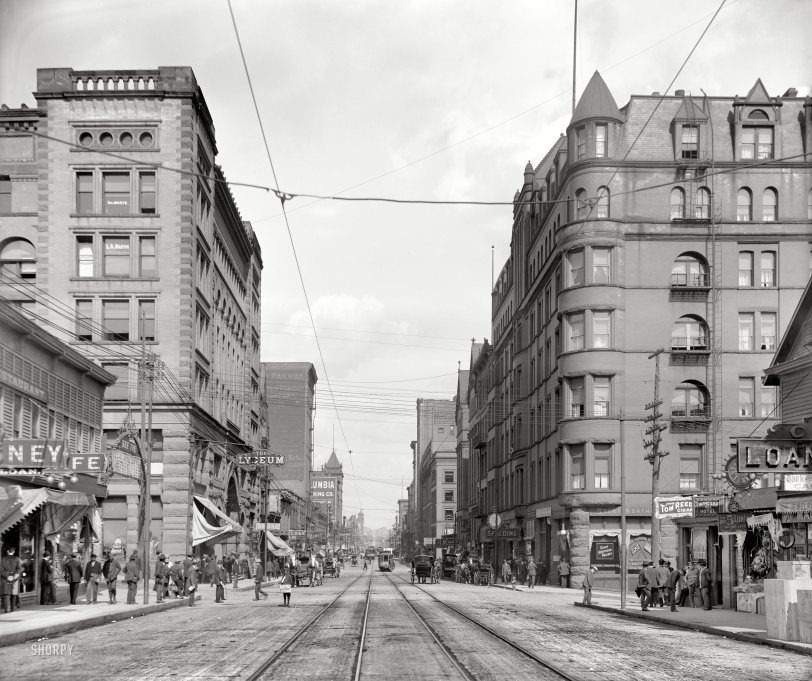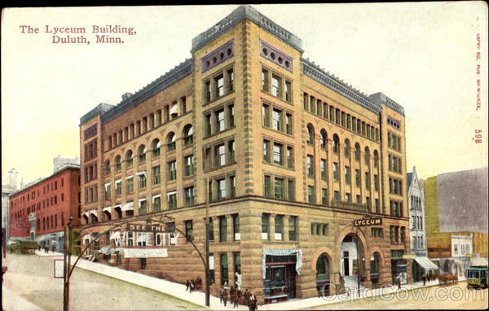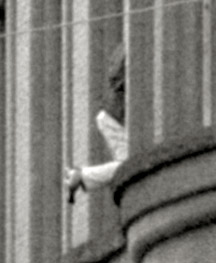


Framed or unframed, desk size to sofa size, printed by us in Arizona and Alabama since 2007. Explore now.
Shorpy is funded by you. Patreon contributors get an ad-free experience.
Learn more.

- S&P
- 1940 Zenith radio model 6G601
- Quality goes in before the name goes on!
- Snazzy skirt
- Carbon Arc Lamps
- Illuminate us
- I remember it well
- I can't prove it
- Complicated then, forgotten now
- Bryan-Stevenson
- Skinny is as skinny does
- How do you rest in peace
- Riding the footboards
- Alas, hidden from view
- Baldwin Diesels
- Exclusive pump
- Bananas, Oysters and Smokey Joe
- Details, Details
- What's that building to the left of the tower?
- Coal Barges
- Bromo-Seltzer
- Inner harbor
- The Basin
- What a headache!
- Giant stepladder?
- Yeah, it was cold
- Love those coats
- Link & Pin Days Remnant
- Baldwin 62303
- Baldwin VO-1000
Print Emporium
Superior Street: 1909

Duluth, Minnesota, circa 1909. "Superior Street." The newsboy's headline: JAP RIOT CRISIS. 8x10 inch glass negative, Detroit Publishing Co. View full size.
Beef tea
Beef tea is nothing more than what we now know as beef broth, beef bouillon, or beef consomme. One of my unfailing go-to beverages when I am feeling puny, or (unfortunately) on a liquid-only diet. Why it was a big deal in 1909 I have no idea. I am more concerned about the dude in the window, whether he is coming or going. My theory is that the husband came home unexpectedly.
How to make it:
Hot Beef Tea
That's what it looks like the sign says. Or maybe it's Hot Beet Tea, which sounds even worse.
Let's not forget
The best 5 cent lunch in the city. Was it the Hot Beef Tea that they were advertising?
Count 'em
There are THREE trolleys running up this street. If I missed one, no problem! I could just wait a minute and hop on the next one!
I'll pass
on the Hot Beef Tea! Although 5 cents is a good price for lunch.
Another Japanese connection
In addition to the "JAP RIOTS" headline, a sign on the Great Northern Railway office announces steamship sailings from Seattle to Yokohoma and Kobe.
On a completely separate note, while street crowds in most vintage cityscapes tend to be predominately male, this one is the most extreme, with almost no women visible. It looks almost like a modern street scene in the Middle East.
Something's missing
Can't find the United Cigar Store!
Hawaii Riots
The newsboy's headline concerns an incident during a labor strike by 10,000 Japanese sugar plantation workers on the island of Oahu in Hawaii. The wire service "riot" story was datelined "Honolulu - June 9" and ran in the New York Times on June 10, 1909. The wider story about this strike and its developments ran in many mainland newspapers throughout June and July, and concerned the efforts of Japanese sugar workers in Hawaii to achieve a wage increase from $18 per month to $22 per month. Much of the press coverage seems to have focused on "yellow peril" conspiracy fears, but a more nuanced report, "Who Will Develop the Wealth of Hawaii?" ran in the Times on June 27, detailing new efforts by white plantation owners to attract Filipino, Portuguese and Puerto Rican immigrants to replace the "restless and ambitious" Japanese.
Jap Riot
The headlines referred to riots in California due to a spate of new laws affecting the Japanese population. Below is an outline of the years before and after the riot. It clearly paints a picture for what happened during WWII.
1906
San Francisco School Board orders segregation of 93 Japanese American students.
1907
On orders from President Theodore Roosevelt, S.F. School Board rescinds segregation order, but strong feelings against Japanese persist. Anti-Japanese riots break out in San Francisco in May, again in October, much to the embarrassment of U.S. government.
Congress passes immigration bill forbidding Japanese laborers from entering the U.S. via Hawaii, Mexico, or Canada.
1908
The Asiatic Exclusion League reports 231 organizations affiliated now, 195 of them labor unions. U.S. Secretary of State Elihu Root and Foreign Minister Hayashi of Japan formalize the Gentlemen's Agreement whereby Japan agrees not to issue visas to laborers wanting to emigrate to the U.S.
1909
Anti-Japanese riots in Berkeley. U.S. leaders alarmed at tone and intensity of anti-Japanese legislation introduced in California legislature.
1910
Twenty-seven anti-Japanese proposals intro-duced in the California legislature. White House urges Governor Hiram Johnson to seek moderation.
1913
Alien Land Law (Webb-Haney Act) passed, denying "all aliens ineligible for citizen-ship" (which includes all Asians except Filipinos, who are "subjects" of U.S.) the right to own land in California. Leasing land Iimited to 3 years. Similar laws eventually adopted in Washington, Oregon, Idaho, Montana, Arizona, New Mexico, Texas, Kansas, Louisiana, Missouri, and Minnesota.
1915
The Hearst newspapers, historically hostile to Japanese, intensifies its "Yellow Peril" campaign with sensational headlines and editorials, fueling anti-Japanese feelings.
Spot the sign
It looks hot and dusty -- perfect venue for a Coca-Cola advertisement!
News of the day?
Can we get a close-up of the newsie to read his tantalizing two-word headline? Any guesses?
[Anyone read the caption under the photo? - Dave]
Fitger's beer
The Lyceum Theatre
Said to be Duluth’s first “fire-proof” theatre. It was built for live theatre in 1892, but in 1921 it was converted to showing movies. Demolished in 1963.

Coming or going?
This guy doesn't appear to be a window washer!

Maybe he stepped on a hat
Two things on the right immediately caught my attention:
1. There is a bald man walking down the street; he appears to be the only man in downtown Duluth not wearing a hat. He must have met with some devastating hat disaster. That shiny pate REALLY sticks out!
2. The man in front of Fitger's Beer who is looking down at his feet or something on the ground. I'm pretty sure he was saying or thinking: "Aw man, what did I just step in?"
























On Shorpy:
Today’s Top 5